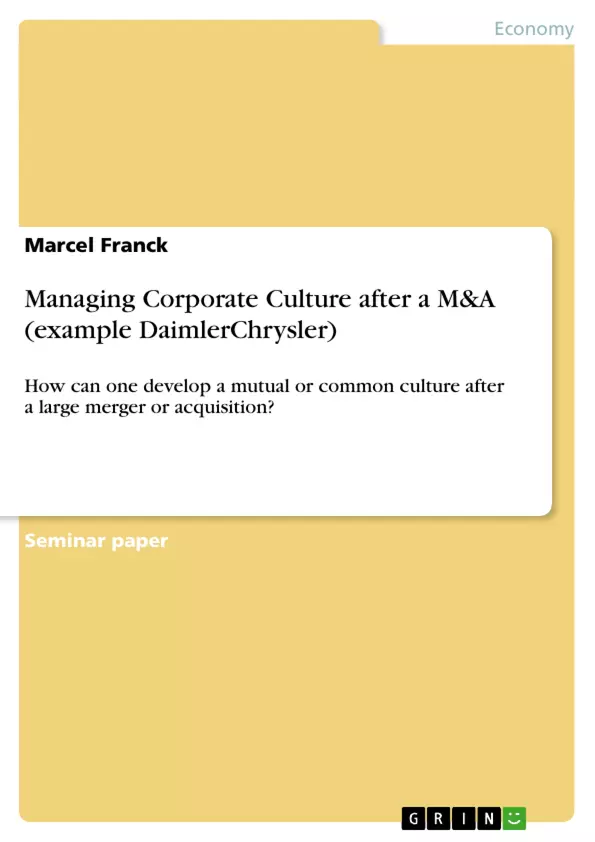In terms of globalization, enterprises have to be aware of their own identity, values and
thoughts and develop a grasp for interaction with foreign cultures. So it’s not only some kind
of business behavior necessary, it is also important to know something about the values,
morals and attitudes for a better interaction. Even more important is a survey, if you plan a
merger or an acquisition with a foreign company. Researches proof, that 50-70 % of all
mergers don’t succeed. This essay deals with the difficulty of consolidating two different
corporate cultures to one common culture. In order to visualize this issue, DaimlerChrysler is
taken as an example. Culture is an “everyday thing”, it is present in every situation. It is a guideline for living
together in large groups, giving rules to act and behave. In most instances these facts are not
written down but unexpressed rules. There are many definitions in literature. The most
widespread definition is likely
“Culture refers to the cumulative deposit of knowledge, experience, beliefs, values, attitudes,
meanings, hierarchies, religion, notions of time, roles, spatial relations, concepts of the
universe, and material objects and possessions acquired by a group of people in the course of
generations through individual and group striving”.
Already the Egyptians and Romans created their own distinct hierarchies, laws, knowledge
bases and values and tried to preserve it over several hundred years. Culture is needed to organize and administrate a group of people or whole population. Nowadays this lead to
sophisticated cultures in every country of the world. These cultures are non-static grown
individual reflections of society that are always adapting to their environment.
Inhaltsverzeichnis (Table of Contents)
- Global cultural interaction
- What is culture?
- Corporate culture
- History of Daimler-Benz and Chrysler
- Characterization of Daimler-Benz and Chrysler
- Changing corporate culture
- Merger & Acquisition
- Process of Merger & Acquisition
- Post Merger Integration
- Sources of trouble
- Summary & Conclusions
Zielsetzung und Themenschwerpunkte (Objectives and Key Themes)
This essay aims to explore the challenges of merging two distinct corporate cultures into a unified whole, focusing on the example of DaimlerChrysler. The main objective is to highlight the difficulties of integrating diverse corporate cultures and offer insights into successful post-merger integration. Key themes covered in the text include:- The importance of cultural understanding in globalization
- The complexity of corporate culture and its role in organizational success
- Challenges of merging distinct corporate cultures in mergers and acquisitions
- The impact of national cultures on corporate culture integration
- Strategies and challenges in managing post-merger integration
Zusammenfassung der Kapitel (Chapter Summaries)
- Global cultural interaction: This chapter emphasizes the significance of cultural awareness in globalization, especially when considering mergers or acquisitions with foreign companies. The high failure rate of mergers (50-70%) underscores the complexity of integrating diverse cultures.
- What is culture?: Culture is defined as a comprehensive framework for social interaction, shaping behavior and values within large groups. The chapter emphasizes the multifaceted nature of culture, encompassing knowledge, beliefs, values, and material objects.
- Corporate culture: This chapter focuses on the evolution of corporate culture, using Daimler-Benz and Chrysler as examples. It examines the historical context, key characteristics, and the process of changing corporate culture.
- Merger & Acquisition: This section briefly introduces the concept of mergers and acquisitions, highlighting their importance in the business world.
- Process of Merger & Acquisition: This chapter delves into the specific processes involved in merging two organizations, emphasizing the complexities and considerations involved.
- Post Merger Integration: The chapter addresses the crucial post-merger integration phase, exploring the sources of potential challenges and the critical factors for successful integration.
Schlüsselwörter (Keywords)
This essay examines the complexities of corporate culture change within the context of mergers and acquisitions. Key concepts include global cultural interaction, organizational culture, DaimlerChrysler, merger and acquisition processes, post-merger integration, and the impact of national cultures. The text analyzes challenges faced in integrating distinct corporate cultures and explores strategies for successful post-merger integration.- Citation du texte
- Marcel Franck (Auteur), 2007, Managing Corporate Culture after a M&A (example DaimlerChrysler), Munich, GRIN Verlag, https://www.grin.com/document/117880



